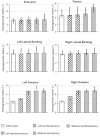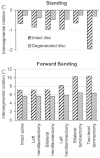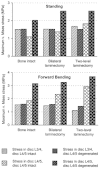Influence of graded facetectomy and laminectomy on spinal biomechanics
- PMID: 12720068
- PMCID: PMC3467787
- DOI: 10.1007/s00586-003-0540-0
Influence of graded facetectomy and laminectomy on spinal biomechanics
Abstract
Facetectomy and laminectomy are techniques for decompressing lumbosacral spinal stenosis. Resections of posterior bony or ligamentous parts normally lead to a decrease in stability. The degree of instability depends on the extent of resection, the loading situation and the condition of the intervertebral discs. The correlation between these parameters is not well understood. In order to investigate how these parameters relate to one another, a three-dimensional, non-linear finite element model of the lumbosacral spine was created. Intersegmental rotations, intradiscal pressures, stresses, strains and forces in the facet joints were calculated while simulating an intact spine as well as different extents of resection (left and bilateral hemifacetectomy, hemilaminectomy and bilateral laminectomy, two-level laminectomy), disc conditions (intact and degenerated) and loading situations (pure moment loads, standing and forward bending). The results of the modelling showed that a unilateral hemifacetectomy increases intersegmental rotation for the loading situation of axial rotation. Expanding the resection to bilateral hemifacetectomy increases intersegmental rotation even more, while further resection up to a bilateral laminectomy has only a minor additional effect. Hemilaminectomy and laminectomy only differ in their effect for ventriflexion and muscle-supported forward bending. Two-level laminectomy increases the intersegmental rotation only for standing. Degenerated discs result in smaller intersegmental rotations and higher disc stresses at the respective levels. Decompression procedures affect the examined biomechanical parameters less markedly in degenerated than in intact discs. Resection of posterior bony or ligamentous elements has a stronger influence on the amount than on the distribution of stresses and deformations in a disc. It has only a minor effect on the biomechanical behaviour of the adjacent region. Spinal stability is decreased after a laminectomy for forward bending, and after a two-level laminectomy for standing. For axial rotation, spinal stability is decreased even after a hemifacetectomy. Patients should therefore avoid excessive axial rotation after such a treatment.
Figures







Similar articles
-
Biomechanical effects of C2-C7 intersegmental stability due to laminectomy with unilateral and bilateral facetectomy.Spine (Phila Pa 1976). 2004 Aug 15;29(16):1737-45; discussion 1746. doi: 10.1097/01.brs.0000134574.36487.eb. Spine (Phila Pa 1976). 2004. PMID: 15303016
-
Comparison of the effects of bilateral posterior dynamic and rigid fixation devices on the loads in the lumbar spine: a finite element analysis.Eur Spine J. 2007 Aug;16(8):1223-31. doi: 10.1007/s00586-006-0292-8. Epub 2007 Jan 6. Eur Spine J. 2007. PMID: 17206401 Free PMC article.
-
Effect of Graded Facetectomy on Lumbar Biomechanics.J Healthc Eng. 2017;2017:7981513. doi: 10.1155/2017/7981513. Epub 2017 Feb 19. J Healthc Eng. 2017. PMID: 29065645 Free PMC article.
-
[Biomechanical aspects of surgical treatment of secondary stenosis of the spinal canal in the lumbosacral region].Ann Acad Med Stetin. 1992;38:97-112. Ann Acad Med Stetin. 1992. PMID: 1290356 Review. Polish.
-
Biomechanics of the posterior lumbar articulating elements.Neurosurg Focus. 2007 Jan 15;22(1):E1. doi: 10.3171/foc.2007.22.1.1. Neurosurg Focus. 2007. PMID: 17608330 Review.
Cited by
-
Does Laminectomy Affect Spino-Pelvic Balance in Lumbar Spinal Stenosis? A Study Based on the EOS X-Ray Imaging System.Acta Neurochir Suppl. 2023;135:405-412. doi: 10.1007/978-3-031-36084-8_62. Acta Neurochir Suppl. 2023. PMID: 38153501
-
Anterior shear strength of the porcine lumbar spine after laminectomy and partial facetectomy.Eur Spine J. 2010 Dec;19(12):2130-6. doi: 10.1007/s00586-010-1492-9. Epub 2010 Jun 27. Eur Spine J. 2010. PMID: 20582709 Free PMC article.
-
Risk factors analysis for spinal deformity following resection of intradural spinal cord tumors from posterior approach: systematic review and meta-analysis.Eur Spine J. 2025 Aug;34(8):3464-3473. doi: 10.1007/s00586-025-08823-y. Epub 2025 Apr 17. Eur Spine J. 2025. PMID: 40244433
-
Fusion criteria for posterior lumbar interbody fusion with intervertebral cages : the significance of traction spur.J Korean Neurosurg Soc. 2009 Oct;46(4):328-32. doi: 10.3340/jkns.2009.46.4.328. Epub 2009 Oct 31. J Korean Neurosurg Soc. 2009. PMID: 19893721 Free PMC article.
-
Non-fusion instrumentation of the lumbar spine with a hinged pedicle screw rod system: an in vitro experiment.Eur Spine J. 2009 Oct;18(10):1478-85. doi: 10.1007/s00586-009-1052-3. Epub 2009 Jun 6. Eur Spine J. 2009. PMID: 19504129 Free PMC article.
References
Publication types
MeSH terms
LinkOut - more resources
Full Text Sources
Medical

